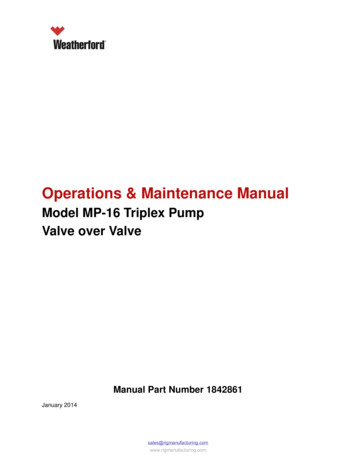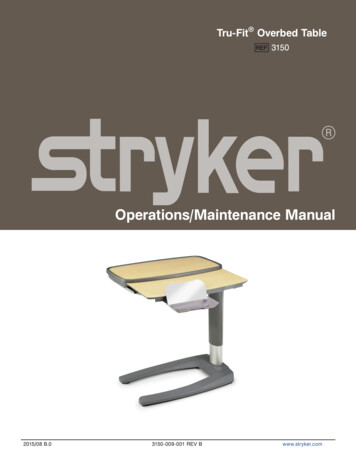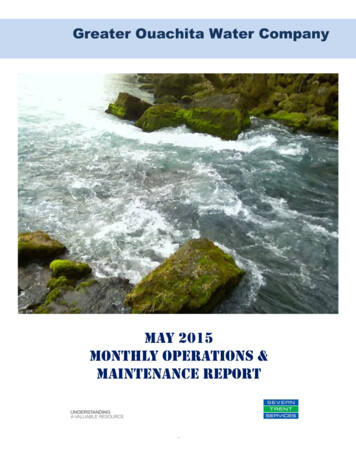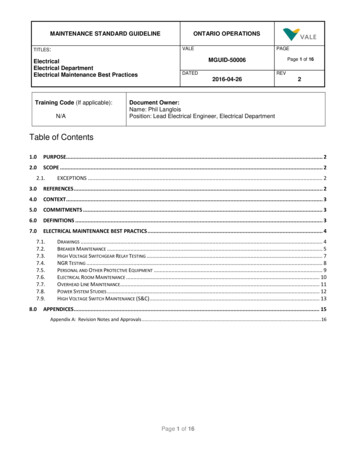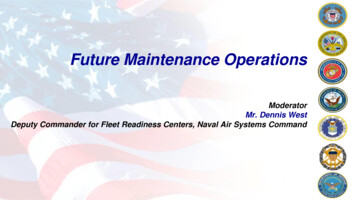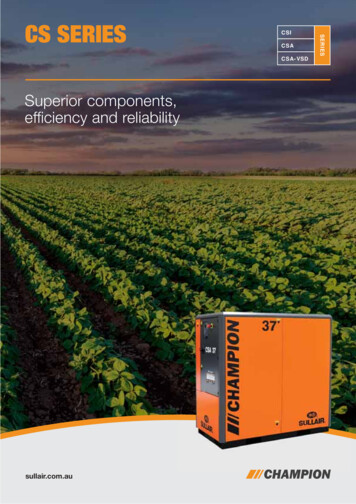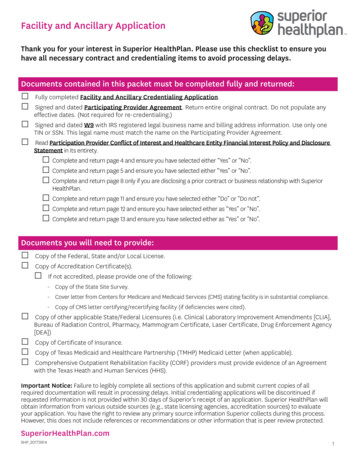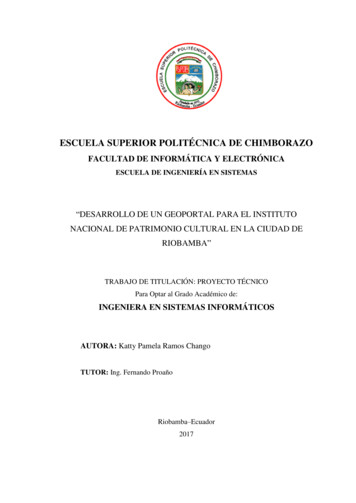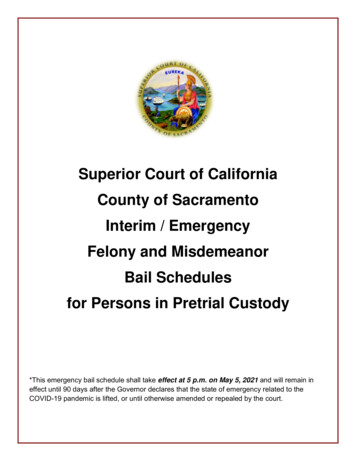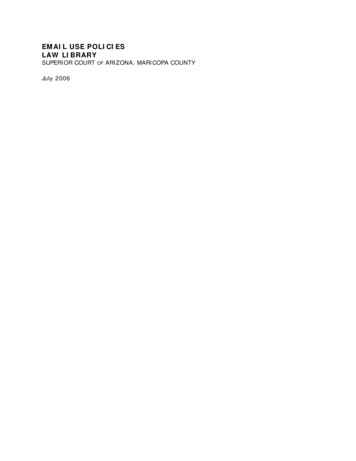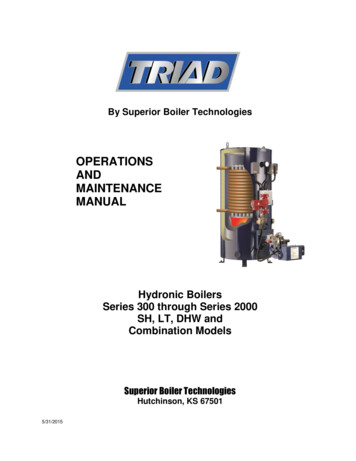
Transcription
By Superior Boiler TechnologiesOPERATIONSANDMAINTENANCEMANUALHydronic BoilersSeries 300 through Series 2000SH, LT, DHW andCombination ModelsSuperior Boiler TechnologiesHutchinson, KS 675015/31/2015
Superior Boiler Technologies!!ATTENTION!!READ THIS MANUAL AND THE BURNER MANUAL VERY CAREFULLY!THEY ARE BOTH VERY IMPORTANT!DO NOT SKIP OVER THE BOILER NOTES AND WARNINGS INSECTION I WHICH CONTAINS INFORMATION THAT MUST BE READAND UNDERSTOOD. SUPERIOR BOILER TECHNOLOGIES IS AMANUFACTURER AND DOES NOT PROVIDE SITE SPECIFICENGINEERING. ALWAYS USE AN EXPERIENCED ENGINEER TODESIGN YOUR SYSTEM.THESE ITEMS IN PARTICULAR ARE VERY IMPORTANT: BOILER SAFETY- Read the Warnings in this manual. VENTING- Draft no more negative than -0.05” wc WATER TREATMENT/QUALITY (See Section I & VII for more detail)- pH between 8.0 and 10.0- Oxygen less than 250 ppb- Total Dissolved Solids (TDS) levels 3000 ppmBURNER/BOILER STARTUP MUST BE PERFORMED BY ANAUTHORIZED TRIAD TECHNICIAN OR WARRANTY WILL BE VOIDED.
Superior Boiler TechnologiesOperations And Maintenance Manual ForHydronic Boiler ModelsTABLE OF CONTENTS:Section IBASIC BOILER WARNINGSSection IIHYDRONIC BOILER MODEL INFORMATIONPacking SlipWiring DiagramsSection IIIBOILER SYSTEM COMPONENTSSection IVGENERAL OPERATIONSSection VINSTALLATION & STARTUP INSTRUCTIONSSection VIOEM COMPONENT MANUALSSection VIIGENERAL MAINTENANCESection VIII TROUBLESHOOTINGFor Technical Service OnlyRetain this manual and keep it readily available, typically near the boiler.
Forward:TRIAD Boilers have a history of over 80 years of superior service. TRIAD patented the originalisolated, modular boiler system concept. Each boiler / burner package has been specificallymatched to provide optimal performance. The OEM (Original Equipment Manufacturer) burners,controls, and pumps are all first quality, name-brand components. The boilers, however, are onlya part of the complete operating system. They can only meet their ratings if the system is properlydesigned and if the boilers receive proper care.Two major things that must be focused on to achieve a successful implementation: Proper SystemDesign and Proactive Preventive Maintenance.While the TRIAD Boiler websitewww.triadboiler.com may address some “Design” issues, a design engineer should be involved.This Operations and Maintenance Manual addresses many “Usage” issues.It is important that the system design matches the performance of the boiler. A compatible designthat addresses combustion air, correct system sizing, fuel and water supply, and breeching iscrucial, and should be the responsibility of the system design engineer who must also ensurelocal code compliance. The boilers will meet their full potential when part of an appropriate systemdesign.Efficient burner operation is highly dependent on proper adjustment, adequate combustion air,and correct breeching. Make sure you carefully read the burner Operating and MaintenanceManual. Incorrectly dealing with these issues can result in, among other things, a loss ofefficiency, higher operating costs, sooting, frequent cleaning, and high carbon monoxide (CO)output.The successful, long-term operation of the boiler is dependent on the quality of its water. Failureto provide suitable water will result in corrosion and the build-up of scale and mud / sludge /sediment causing inefficient thermal transfer, an associated loss of efficiency, higher operatingcosts, and eventually lead to premature boiler failure.Being cognizant of these issues, and taking proper steps when required, should result in manyyears of successful boiler operation.Superior Boiler Technologies3524 E. 4th AvenueHutchinson, KS 67501Ph: 620-662-6693
SUPERIOR BOILER TECHNOLOGIESSection IBASIC BOILER WARNINGSSTOP: Do not go on without readingall of this section first.in Section VI and the respective burnermanufacturer's installation and instruction manualincluded with the boiler or burner.TRIAD STRONGLY RECOMMENDSTHATTHESYSTEMDESIGNENGINEER THOROUGHLY REVIEWTHIS MANUAL AND THE BURNERMANUFACTURER'S MANUAL BEFOREINSTALLATION AND STARTUP.The third and very important step is toensure that the system, and in particularthe water, fuel and air supply, venting,and breeching components have been properlyinstalled and meet local codes before placing theboiler in operation.ALLOPERATORSSHOULDBEFAMILIAR WITH THIS MATERIAL - THISMANUAL SHOULD BE READ, ITSMATERIAL UNDERSTOOD, AND ITSINSTRUCTIONS FOLLOWED. THISMANUAL SHOULD BE READILYAVAILABLE IN THE BOILER ROOM ASA REFERENCE.ONLY TRAINED AND QUALIFIEDINDIVIDUALSEXPERIENCEDINBOILER ROOM / LOCAL CODEREQUIREMENTS SHOULD BE USEDTO INSTALL THE SYSTEM.WARNING: The first and most criticalstep in the installation and startupprocedure for any boiler system is tocarefully read and understand the WARNINGS inthis sectionWARNING:Prior to startup it isimportant to verify the boiler has beensufficiently filled with water via theexpansion tap or supply tap to a levelabove the LWCO control. This is very important fora boiler with an optional coil - do not simply fill thecoil with water.CAUTION: The second and veryserious step is to review all of thematerial in this manual including theoriginal equipment manufacturer's(OEM) component instruction information includedWARNINGSThe fourth and ongoing step is to ensure that thesystem is properly maintained.WARNING: It is important to make sure the mainpower switch and all power to the boiler is OFFprior to removing the cover of the main control box.TRIAD Boilers can give years of dependableservice with proper maintenance and by carefullyfollowing the instructions in this manual, thematerial covering OEM controls, and the burner.Failure to follow the directions and warnings canresult in property damage or serious injury.Independent Operation -- the boiler, controls, andattached pumps and accessories are activated byseveral controls and by the "Call For Heat" circuit.These can include remote sensors and controls.As a result, these components can be supplied withelectricity and/or operate without warning. It isimperative that all power is removed and thecontrol signal(s) is "locked out" before anymaintenance is done on the boiler system.NOTE: Ensure proper venting by consulting astack engineer. Proper boiler venting is critical foroperation of your boiler. The flue must be as largeand probably larger than the diameter of the collaropening. Actual sized depends on total distance offlue. It is important to keep the vent pressure at anegative and it is even more important that thepressure is no more negative than -0.05” wc. Forexample, a negative pressure such as -0.10” wc,could cause the burner flame to be pulled up intothe firetubes, effectively over firing the boiler. Aproperly sized barometric damper will help mitigatethis.SECTION I
Breeching, Fuel, and Burner Operations -- Theburner manual as provided by the manufacturercontains a number of warnings concerning properoperation. Failure to follow these instructions,improper maintenance, improper or inadequatecombustion air, fuel supply systems, or breechingcan result in exposure to Carbon Monoxide or otherhazards that can result in property damage,possible explosion, serious injury, or death.Operating Limits -- Boilers heat water underpressure. When water is heated above its boilingpoint it can flash to steam if the pressure isremoved. In addition, "dry firing a boiler" (applyingheat to a boiler with inadequate water inside) canresult in an extremely destructive and hazardouscondition caused by the rapid and potentiallyexplosive buildup of extreme pressures andtemperatures.According to the National Board Bulletin/Fall 2007,it is a good idea to post signage near the boiler thatstates something similar to the following:EXPLOSION WARNING - Do Not Introduce WaterInto or Onto an Overheated BoilerThe boiler contains several limit controls to preventexcessive temperatures, but make sure thesecontrols are properly set, maintained, andoperated.Boiler controls must NEVER be bypassed,improperly set, or overridden. If any manual resetcontrol device has been tripped, the boiler controlmust NEVER be reset until the system has beenthoroughly checked by a qualified technician.Failure to follow this warning can result in damageto the vessels and possible serious injury.The following is a list of Recommendations for aBoiler Room derived from the National Board ofBoiler and Pressure Vessel Inspectors:1) Keep the boiler room clean and clear of allunnecessary items. The boiler room should not beconsidered an all-purpose storage area. Theburner requires proper air circulation to preventincomplete fuel combustion and the production ofcarbon monoxide.2) Ensure that all personnel who operate ormaintain the boiler room are properly trained on allequipment, controls, safety devices, and up-todate operating procedures.3) Before startup, ensure that the boiler room isfree of all potentially dangerous situations, likeWARNINGSflammable materials that could cause mechanicalor physical damage to the boiler or relatedequipment. Clear intakes and exhaust vents andcheck for deterioration and possible leaks.4) Ensure a thorough inspection by a properlyqualified inspector, such as one who holds aNational Board commission.5) After any extensive repair or new installation ofequipment, make sure a qualified boiler inspectorre-inspects the entire system.6) Monitor all new equipment closely until safetyand efficiency are proved.7) Use boiler operating log sheets, maintenancerecords, and the manufacturer's recommendationsto establish a preventive maintenance schedulebased on operating conditions, repair, andreplacements performed on the equipment.8) Establish a checklist for proper startup andshutdown of boilers and all related equipmentaccording to the manufacturer's recommendations.9) Observe equipment extensively before allowingautomatic operating systems to be used withminimal supervision.10) Establish a periodic preventive maintenanceand safety testing program that follows CSD-11995, Part CM and the manufacturer'srecommendations.TRIAD reminds end-users that boilers and boilerrooms may fall under many code and regulatoryrequirements, with local jurisdiction usuallycontrolling. Installation should be carried out bycompetent personnel in accordance with thestandards of the National Fire ProtectionAssociation, National or Canadian Electrical Code.However, NEC, ANSI, ASHRAE, ons must also be considered.Mandatory compliance with ASME code asadministered by the National Board may berequired in some instances.TRIAD / SUPERIOR very strongly recommendsthat a competent and knowledgeable systemdesign engineer be given design andimplementation responsibility.WATERSECTION I
Properly treated vessel water is highly important,and critical for normal boiler service life and correctoperation. This is water free of excessive mineralsand gases with a nominal pH of 8.0 – 10.0. A pHlevel only a single digit away from thisrecommendation can make a dramatic difference each increasing level of pH is ten times greaterthan the prior level. So for example, a pH of 8 is tentimes more acidic than a pH of 9, and one hundredtimes more acidic that a pH of 10. Conversely, a pHof 8 is ten times more basic (alkaline) than pH of 7.Water ItemspHTDSHardness CaCO3Levels7.5 to 9.5 2000 ppm 10 ppm(Calcium Carbonate)AlkalinityOrganic CarbonIronSuspended Solids 300 ppmNo sheen or Foam (1)Colorless Liquid (2)No visual turbidity (3)(1) Organic Carbon – After a water sample sits for10 minutes there should be no visible solids.(2) Iron – Hold a water sample against a whitebackground and there should be no visible yellow,red, or orange tinge.(3) Suspended solids – Vigorously shake a watersample for 30 seconds. There should be no visiblesheen or foam.Water samples should be taken from the lower partof the boiler, not from an area higher up such asthe gauge glass.Scale is a very effective insulator that will cause aloss of heat transfer efficiency and eventually tubesheet failure. Hard water results in a high amountof suspended solids. This condition is not coveredunder the boiler warranty.corrosive the water. These can be controlled byincreasing the amount of corrosion inhibiter orchanging the type of inhibiter used.Dissolved Oxygen – High levels in the boiler cancause pitting. It is very difficult to stop pitting onceit has started, and can proceed very quickly.Oil – Oil can get into boiler water from varioussources, including high levels in a new boiler, orfrom the condensate. It can contribute to scaleformation.pH – This is a measure of the level of acid or baseof water. If too low (acidic) corrosion will increase,if too high then scale can develop. It can also causewater carryover. It is very important to continuouslymonitor pH levels.Phosphates – High levels can cause scaleformation. It usually comes from some type ofpollution in the groundwater.Sodium Sulfite – This is used to remove dissolvedoxygen before it gets to the boiler. It reacts withoxygen to produce sodium sulfate (versus sulfite).Water should have slightly more than enoughsodium sulfite to consume all the dissolved oxygen.If not fed continuously, the boiler may not beprotected from oxygen corrosion. This is a veryimportant aspect of water treatment.TDS – Total Dissolved Solids is undissolvedorganic matter such as dirt and silt in the water.This can cause high water hardness.A thorough review by a qualified watertreatment system specialist should be done,and their recommendations followed.Water that is too soft can be even more aggressive,so a minimum hardness is usually recommended.Other items that also are harmful to the boilersinclude silica, iron, chlorides, and phosphates.Following are severalterminology items:watertreatmentAlkalinity – Levels of this determine the ability ofacids to be neutralized in water. Alkalinities canform carbon dioxide which is a primary culprit incorrosion. High levels can be from
31.05.2015 · step in the installation and startup procedure for any boiler system is to carefully read and understand the WARNINGS in this section WARNING: Prior to startup it is important to verify the boiler has been sufficiently filled with water via the expansion tap or supply tap to a level above the LWCO control. This is very important for a boiler with an optional coil - do not simply fill the coil .
